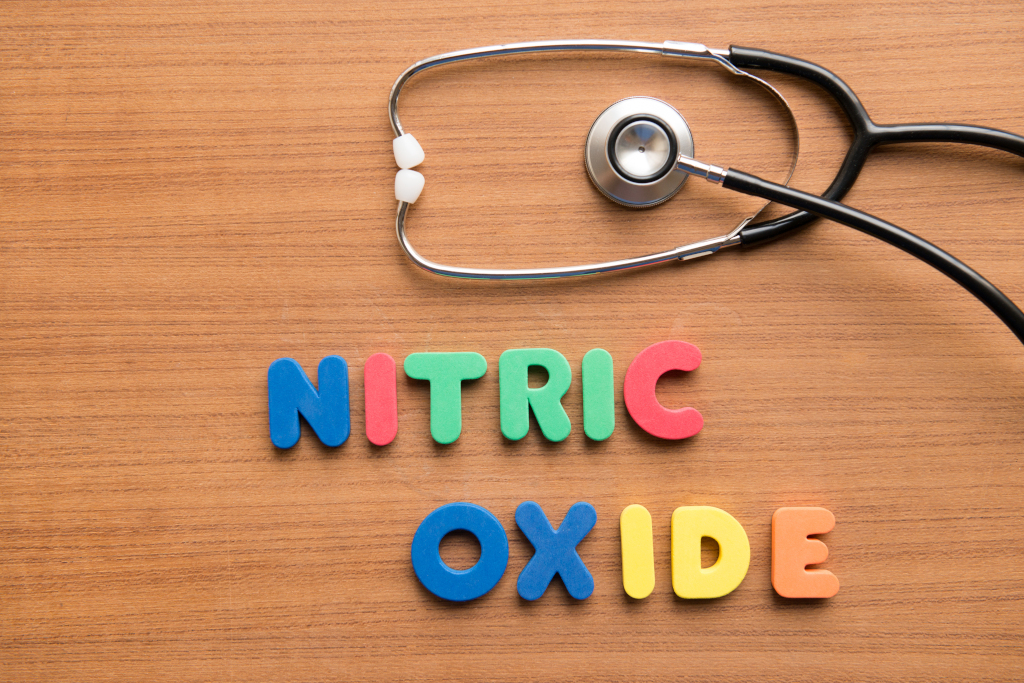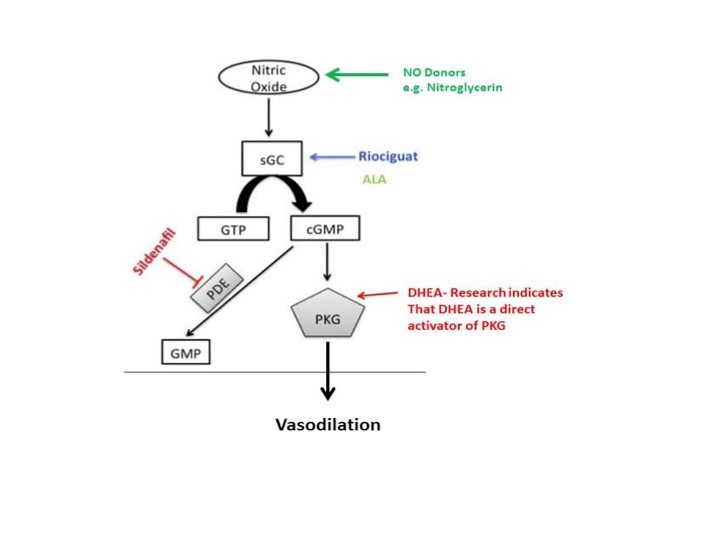Pharmacological Interventions Targeting the Nitric Oxide Pathway
Healthful Vitality | 03/02/2020 | By Dr Anand Lakhkar, MD, PhD | Pharmacological Interventions Targeting the Nitric Oxide Pathway

The nitric oxide (NO) pathway is one of the most widely targeted pathways for treatment of cardiovascular disease. Notably, The Nobel Prize was awarded in 1998 to Drs Furchgott, Murad and Ignarro for their role in the discovery of NO.
What is Nitric Oxide?
NO is the smallest gasotransmitter. It is produced by enzymes called as NO synthases. There are three types of NO synthases: 1) endothelial NOS 2) neuronal NOS and 3) inducible NOS. The No producing isozymes use L-arginine and oxygen and the reduced form of nicotinamide-adenine-dinucleotide phosphate (NADPH) as substrates. Also, they use use 6R-5, 6, 7, 8-tetrahydro-L-biopterin (BH4) as essential cofactor for the generation of NO and L-citrulline. The endothelial NOS is the major enzyme responsible for generating NO in the blood vessels (1).
What Does NO do in the body?
NO is a vasodilator i.e. it relaxes the blood vessels. Indeed, it also exerts anti-hypertensive, anti-thrombotic and anti-atherosclerotic effects. Additionally, it causes dilatation of the blood vessels by activating the cyclic guanosine monophosphate (cGMP)-Protein Kinase G (PKG) pathway. Moreover, endothelial dysfunction leading to impairment of NO signaling is a major contributor to cardiovascular diseases.
Given its role in the pathogenesis of cardiovascular diseases, a variety of drugs have been developed which target the NO pathway. Namely, the NO pathway is of particular importance for the treatment of pulmonary hypertension.
Drugs Targeting the NO Pathway
1) Organic Nitrates
The organic nitrates are the most commonly used NO donor drugs.
Drugs targeting the NO pathway are:
Mechanism – The prototype is nitroglycerine. Truly, nitroglycerin is denitrated by glutathione S -transferase in the smooth muscle and other cells. As a result, free nitrite ion is released which is then converted to nitric oxide. Furthermore, they relax large arteries as well as large veins. Notably, these drugs increase the collateral blood flow, decrease ventricular volume and arterial blood pressure. All of these are beneficial in patients of Angina.
Indications– The main use of these drugs is for treatment of Angina.
Side-effects – Reflex Tachycardia due to the vasodilator effect can increase myocardial oxygen requirement in patients of Angina. In fact, other side effects include orthostatic hypotension, throbbing headache. Evidently, the use of nitrates can result in development of tachyphylaxsis.
2) Phosphodiesterase-5 (PDE-5) inhibitors
These drugs inhibit the enzyme PDE-5 which causes degradation cGMP. By inhibiting PDE-5. to point out, they prevent the degradation of cGMP. Indeed, this leads to activation of PKG and vasodilatation of the vasculature.
Mechanism – By inhibiting PDE-5, they prevent the degradation of cGMP thereby leading to a prolonged vasodilator effect.
Indications –
- Pulmonary Arterial Hypertension
- Erectile Dysfunction
Drugs – Sildenafil is the prototype agent. Another example is tadalafil or vardenafil
3) Activators of sGC
This class of drugs stimulate the NO pathway by activating sGC. Notably, activation of sGC leads to activation of cGMP which in turn activates PKG and causes relaxation of the vasculature. Indeed, Riociguat is the prototype agent for this group.
Mechanism – By activating sGC, these drugs stimulate the formation of cGMP and thus lead to a vasodilator effect.
Indications –
- Chronic Thromboembolic Hypertension
- Pulmonary Arterial Hypertension
Side Effects – Hypotension, Headache, GI Disorders
Potential New Agents Targeting the NO Pathway:
1) Dehydroepiandrosterone (DHEA):
DHEA is one of the most abundant circulating steroid hormones in the body. It is produced endogenously. Notably, there has been a great deal of interest in studying this molecule for the treatment of pulmonary hypertension and associated right heart failure. Some animal studies have shown that it restores right ventricular function in animal models of pulmonary hypertension (6). DHEA is believed to target different pathways. Studies have shown that DHEA causes relaxation of the pulmonary vessels by targeting the NO pathway. It directly activates PKG by a non NO, non cGMP dependent mechanism known as PKG dimerization (2, 3, 4).
Unlike other drugs available in the market, it is a direct activator of PKG (Figure 1). By directly targeting PKG, it acts more down-stream in the NO pathway. Even if there is endothelial dysfunction and disruption of the NO signalling, DHEA can still cause vasodilatation and relaxation of the vasculature by acting downstream and directly activating PKG. A phase 2 study evaluating the effects of DHEA in pulmonary hypertension is currently underway (7).
2) δ-aminolevulinic acid (ALA)
ALA is also being investigated to treat pulmonary hypertension. Studies have shown that it targets the NO pathway by activating sGC (Figure 1) which in turn stimulates PKG (5).

Note- DHEA and ALA are not currently FDA approved for the treatment of pulmonary hypertension. The mechanisms shown in the above schematic are based on in-vitro/animal research studies.
Also Read: Useful Tips for Surgery Preparation and Faster Recovery
References:
- Forte M, Conti V, Damato A, et al. Targeting Nitric Oxide with Natural Derived Compounds as a Therapeutic Strategy in Vascular Diseases. Oxid Med Cell Longev. 2016;2016:7364138. doi:10.1155/2016/7364138
- Lakhkar A, Dhagia V, Joshi SR, et al. 20-HETE-induced mitochondrial superoxide production and inflammatory phenotype in vascular smooth muscle is prevented by glucose-6-phosphate dehydrogenase inhibition. American Journal of Physiology – Heart and Circulatory Physiology. 2016;310(9):H1107H1117.doi:10.1152/ajpheart.00961.2015.
- Lakhkar Anand & Raj Joshi, Sachindra & A.Gupte, Sachin. (2014). Regulation of cGMP by glucose-6-phosphate dehydrogenase through PDE5 In coronary artery. https://www.researchgate.net/publication/297713864_Regulation_of_cGMP_by_glucose-6-phosphate_dehydrogenase_through_PDE5_In_coronary_artery
- Patel, D., Kandhi, S., Kelly, M., Neo, B. H., & Wolin, M. S. (2014). Dehydroepiandrosterone promotes pulmonary artery relaxation by NADPH oxidation-elicited subunit dimerization of protein kinase G 1α. American Journal of Physiology – Lung Cellular and Molecular Physiology, 306(4), L383–L391.
- Alhawaj, R., Patel, D., Kelly, M. R., Sun, D., & Wolin, M. S. (2015). Heme biosynthesis modulation via δ-aminolevulinic acid administration attenuates chronic hypoxia-induced pulmonary hypertension. American Journal of Physiology – Lung Cellular and Molecular Physiology, 308(7), L719–L728.
- Abdallah Alzoubi, Michie Toba, Kohtaro Abe, Kealan D. O’Neill, Petra Rocic, Karen A. Fagan, Ivan F. McMurtry, and Masahiko Oka (2013). Dehydroepiandrosterone restores right ventricular structure and function in rats with severe pulmonary arterial hypertension. American Journal of Physiology-Heart and Circulatory Physiology 2013 304:12, H1708-H1718
- https://clinicaltrials.gov/ct2/show/NCT03648385
